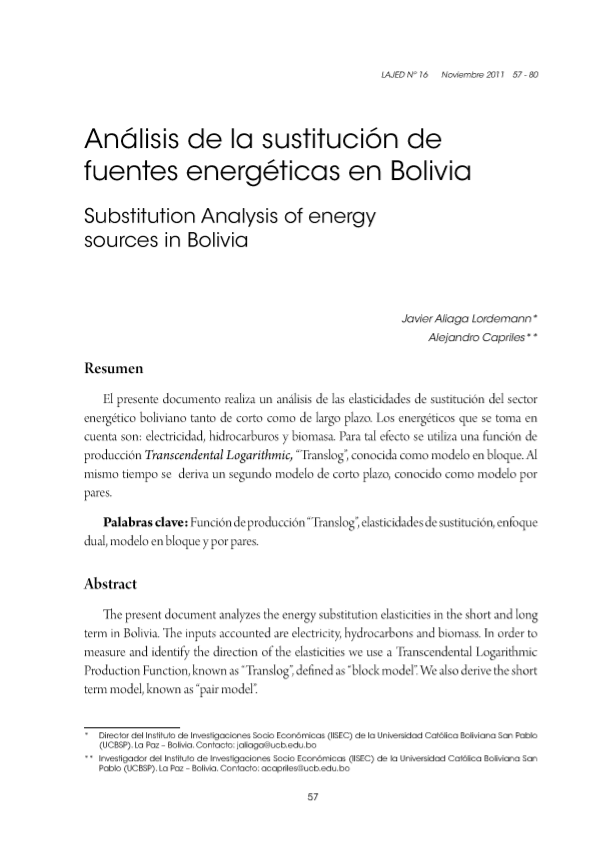Substitution Analysis of energy sources in Bolivia
DOI:
https://doi.org/10.35319/lajed.201116146Keywords:
substitution elasticities, the dual approach, block and peers modelsAbstract
The present document analyzes the energy substitution elasticities in the short and long term in Bolivia. The inputs accounted are electricity, hidrocarbons and biomass. In order to measure and identify the direction of the elasticities we use a Trancendental Logarithmic Production Function, know as "Translog", defined as "block model". We also derive the short term model, know as "pair model".
Downloads
References
Adeyemo, O. O., Mabugu, R. y Hassan, R. H. (2007). Interfuel substitution: the case of the Nigerian industrial sector. Journal of Energy in Southern Africa, 18 (1)
Allen, R. (1938). Mathematical Analysis for Economists. Londres: Macmillan.
Anderson, R. y Moroney, J. (1993). Morishima Elasticities of substitution with nested production functions. Economics Letters, 42: 159-166.
Astorga, A. y Rodriguez, J. (1984). La función exponencial y la función logarítmica. Instituto Tecnológico de Costa Rica Escuela de Matemática.
Atkinson, S. y Halvorsen, R. (1976). Interfuel Substitution in Steam Electric Power Generation. The Journal of Political Economy, 84 (5): 959-978. University of Chicago Press.
Bacon, R. (1992). “Measuring the possibilities of Interfuel Substitution”. Working Paper, Country Economic Departament, The World Bank.
BID (2006). “Plan Maestro de Electrificación Rural”
Blackorby, Ch. y Russell, R. (1981). The Morishima Elasticity of Substitution: Symmetry, Constancy, Separability, and Its Relationship to the Hicks and Allen Elasticities. Review of Economic Studies, 46: 527-31, julio.
Bong, C. y Labys, W. (1988). Application of the translog model of energy substitution to developing countries: The case of Korea. Energy Economics, 10: 313-323.
Christensen, L., Jorgenson, D. y Lau, L. (1973). Transcendental Logarithmic Production Frontiers. The Review of Economics and Statistics, 55 (1), 28-45, febrero.
Christev, A. y Allen, F. (2005). A Note on Allen-Uzawa Partial Elasticities of Substitution: The Case of the Translog Cost Function. Heriot Watt University. School of Management and Languages Discussion Paper Series in Economics ISSN 1741-8240. DP2004-E07.
CNDC. (2010). Revista mensual de los resultados de la operación del sistema interconectado nacional (sin) y del mercado eléctrico mayorista (mem).
Considine, T. (1989). Separability, functional form and regulatory policy in models of interfuel substitution. Energy Economics, 11: 82-94.
Diewert, W. (1974). Applications of Duality Theory. En: Intriligator y Kendrick (eds). Frontiers of Quantitative Economics. Vol. II: 106-171. Amsterdam, North-Holland.
Diewert, W. y Wales, T. (1987). Flexible Functional Forms and Global Curvature Conditions. Econometrica, January, 55(1): 43-68.
Ernst, R. y Wood, D. (1975). Technology, Prices, and the Derived Demand for Energy. The MIT Press.
Griffin, J. y Gregory, P. (1976). An Intercountry Translog Model of Energy Substitution. Responses. The American Economic Review, 66(5): 845-857, December.
Hall, V. (1986). Major OECD country industrial sector interfuel substitution estimates, 1960-1979. Energy Economics, 8: 74-89.
Henderson, J. y Quandt, R. (1981). Teoría microeconómica. Una aproximación matemática. Ariel.
Hertel, T. (1984). Applications of the Duality and Flexible Functional Form: The Case of the Multiproduct Firm. Research Bulletin 980, Purdue University, September, 15-20.
Hicks, J. (1932). Theory of wages. New York: St. Martin Press.
Jones, C. (1995). A dynamic analysis of interfuel substitution in US industrial energy demand. Journal of Business and Economics Statistics, 13: 459-465.
Lau, L. (1978). Testing and Imposing Monotonicity, Convexity, and Quasi-Convexity Constraints, in: Fuss and McFadden, eds., Production Economics: A Dual Approach to Theory and Applications Vol. I. Amsterdam, North-Holland.
Mara, H. (2000). Operaciones con números índices. Universidad de los Andes. Seminario de Economía Aplicada. Sección Única.
Ministerio de Hidrocarburos y Energía. (2007). Balance energético Nacional (BEN).
Morrissett, I. (1953): Some Recent Uses of Elasticity of Substitution. A Survey. Econométrica, January, 21(1): 41-62.
Newey, W. y West, K. 1987. A Simple, Positive Semi-definite, Heteroskedasticity and Autocorrelation Consistent Covariance Matrix. Econométrica, Econometric Society, vol. 55(3): 703-08, May.
Østbye, S. (2004). The Translog Neoclassical Growth Model. Universitetet I Tromsø. Department of Economics and Management Norwegian College of Fishery Science University of Tromsø Norway Working Paper Series in Economics and Management No. 02/04.
Pyndick, R. (1977). Interfuel Substitution and the Industrial Demand for Energy: An International Comparison. Massachusetts Institute of Technology. Working Paper.
Ramsey, J. (1969): Tests for Specification Errors in Classical Linear Least-Squares Regression Analysis. Journal of the Royal Statistical Society. Series B (Methodological), 31 (2): 350-371.
Russell, S., Paresh, K. y Hongliang, S. (2010). Inter-fuel Substitution in the Chinese Iron and Steel Sector. Monash University. Business Economics. Department of Economics ISSN 1441-5429 Discussion paper 22/10.
Serletis, A. y Shahmoradi, A. (2008). Semi-nonparametric estimates of interfuel substitution in US energy demand. Energy Economics, 30: 2123-2133. 18
Serletis, A., Timilsana, G. y Vasetsky, O. (2009). International evidence on interfuel substitution. World Bank Working Paper.
Serletis, A., Timilsana, G. y Vasetsky, O. (2010). Interfuel substitution in the United States. Energy Economics, 32: 737-745.
Stern, D. (2009). Interfuel Substitution: A Meta-Analysis. Australian National University, Arndt-Corden Division of Economics, Research School of Pacific and Asian Studies.
Tuthill, L. (2008). Interfuel Substitution and Technical Change in the US Electricity Generating Industry Under the Tradable Sulphur Allowance Scheme: 1990–2004. Oxford Institute for Energy Studies.
Uri, N. (1979). Energy Demand and Interfuel Substitution in India. European Economic Review, 12:181-90.
Uzawa, H. (1962). Production Functions with Constant Elasticities of Substitution. Review of Economic Studies, 29: 291-299, Octubre.
Yacimientos Petrolíferos Fiscales de Bolivia, YPFB (2010). “Boletín estadístico Yacimientos Petrolíferos Fiscales Bolivianos”.






